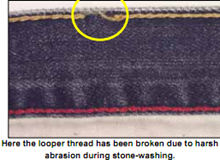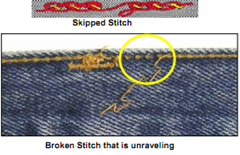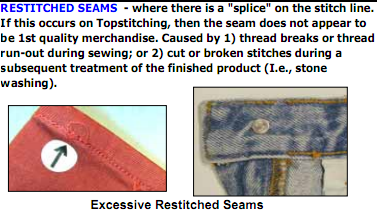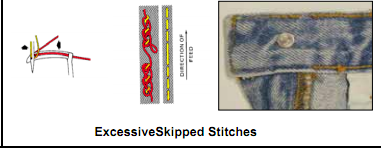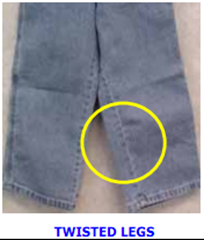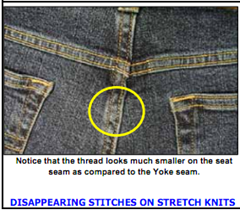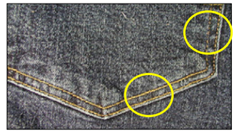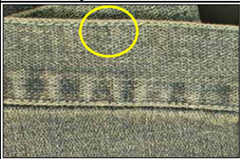
1.BROKEN STITCHES – NEEDLE CUTTING
Description : Where the thread is being broken where one seam crosses another seam (ex: bartacks on top of waistband stitching, seatseam on top of riser seam ) resulting in stitch failure.
Recommended solution by A & E :
- Use a larger diameter thread on operations
where the thread is being cut. - Make sure the proper stitch balance is being used. On a chainstitch seam on denim, you normally would like to maintain a 60%/40%
relationship of Needle thread to Looper thread in the
Seam. - Use needles with the correct needle point.
- Change the needles at regular intervals on operations
where the Needle Cuts are occurring frequently. - Use a higher performance Perma Core or D-Core thread.
2.Broken Stitch – Abrasion :
Description : where the thread is broken during stone-washing, sand blasting, hand sanding, etc. Broken stitches must be repaired by restitching over the top of the stitch-line.
Recommended Solution :
- Use a larger diameter thread on operations where
excessive abrasion is occuring (ex: use T-120 on
Waistband); - Make sure stitches are balanced properly.
- Use a Magic air entangled thread in the looper due to its lower
seam profile making it susceptible to abrasion
(ex: use T-90 or T-135 Magic in loopers of the Yoke, Seat
and Waistband seam); - Monitor the Finishing Cycle for compliance to specs.
3. Broken Stitches : Chemical Degradation :
Description : where thread is being compromised by the chemicals used during laundering resulting in loss or change of color and seam failure.
- It is recommended to go to larger thread sizes when the
Denim Garments will be subject to Harsh Chemical
washes. - To achieve the best laundering results make
sure that the water temperatures and PH Levels are
correct and that the proper amounts and sequence of
chemical dispersion are within guidelines. - Make sure the garments are being rinsed properly to neutralize the
chemicals in the fabric. - Monitor the drying process, cycle times, and temperatures to make sure they are correct so that the best possible garment quality can be
achieved.
4. Unravelling Seams :
Description : where either the stitch has been broken or a skipped stitch has
occurred. This will cause seam failure unless the seam is Restitched.
Recommended Solution :
- This may include going to a higher
performance thread designed to minimize sewing
interruptions. - Observe sewing operators for correct
material handling techniques.
6. Sagging or Rolling Pockets :
Description : where the pocket does not lay SAGGING OR ROLLING POCKETS flat and rolls over after laundering.
Recommended Solution :
- Make sure the sewing operators are not holding POCKETS
back excessively when setting the front pocket. - Make sure the hem is formed properly and that excessive
fabric is not being being put into the folder that will cause
the hem to roll over. - Check to make sure pocket is cut properly and that pocket curve is not too deep.
- Use a reinforcement tape on the inside of the pocket that may
help prevent the front panel from stretching along the bias
where the front pocket is set. - The type and weight of denim, along with the fabric construction, may contribute to this problem. Contact your fabric supplier for assistance.
5.Skipped Stitches
Description: where the stitch forming device misses the
needle loop or the needle misses the looper loop. Skips are usually
found where one seam crosses another seam and most of the time
occurs right before or right after the heavy thickness.
Recommended Solution :-
- Use corespun thread.
- Use minimum thread tension to get a balanced stitch.
- Use the ideal foot, feed and plate that helps to minimize
flagging. - Training sewing operators NOT to stop on the
thickness. - Make sure the machine is feeding properly
without stalling. - Make sure the machine is not back-feeding.
6. Ragged – Inconsistent Edge
Description : where the edge of the seam is
either extremely “ragged” or “rolls” inside the stitch.
Recommended Solution :
- Make sure the sewing machine knives are sharpened and
changed often. - The knives should be adjusted properly in relationship to the “stitch tongue” on the needle plate to obtain the proper seam width or width bite.
7. Wavy Seams On Stretch Denim
Description : where the seam does not lay flat and is wavy due to the fabric stretching as it was sewn or during subsequent laundering and handling operation.
Recommended Solution :
- Use minimum presser foot pressure.
- Instruct sewing operators to use proper handling techniques and not
stretch the fabric as they are making the seam. - Where available, use differential feed to compensate for the
stretch of the fabric.
8. Ropy Hem
Description: is where hem is not laying flat and is skewed in ROPY HEM
appearance .
Recommended Solutions :
- Instruct the sewing operator to make sure they get the hem started correctly in the folder before they start sewing.
- Also, make sure the don’t hold back
excessively as the seam is being sewn. - Use minimum roller or presser foot pressure.
9. Twisted Legs :
Description : is where the sideseam twists around to the front of the pant and distorts the appearance of the jeans .
Recommended Solution :
- Instruct the sewing operator to
match the front and back properly so they come out the
same length. Sometimes notches are used to insure proper
alignment. They should NOT trim off the front or back with
scissors to make them come out the same length. - Make sure the cut parts are of equal length coming to the
assembly operation. - Check fabric quality and cutting for proper skew.
- Make sure the sewing machine is adjusted
properly for uniform feeding of the top and bottom plies
8. Disappearing Stitches in Stretch Denim
Description : is where the thread looks much smaller on seams sewn in the warp direction than in the weft direction of the fabric
Recommended Solution :
- Use a heavier thread size (T-120, ON STRETCH DENIM
T-135, T-150) on topstitching. - Go to a longer stitch length (from 8 to 6 spi). 3) Make sure the thread tensions are as loose as possible so the thread sits on top of the
fabric rather than burying in the fabric on seams sewn in
the warp.
10. Thread Discoloration after Laundry
Description : is where the thread pics up the indigo dyes from the fabric giving the thread a ‘dirty’ appearance. A common discoloration would be the pick-up of a greenish or turquoise tint.
Recommended Solution :
- Use thread with proper color fastness characteristics.
- Correct PH level (too low) and Water Temperature (too low) during
laundry. - Use the proper chemicals & laundry cycles.
- Use Denimcol PCC in wash or similar additive.
- Do Not overload washers with too many garments at one time
Need further info on denim stitching , visit A&E website or contact them.




